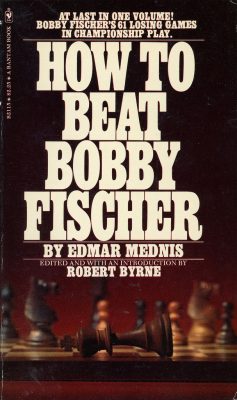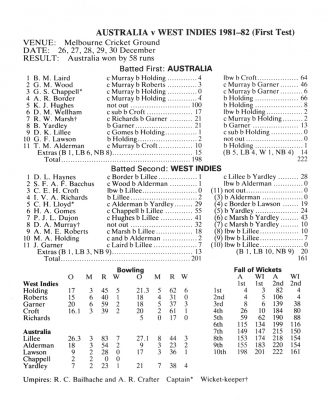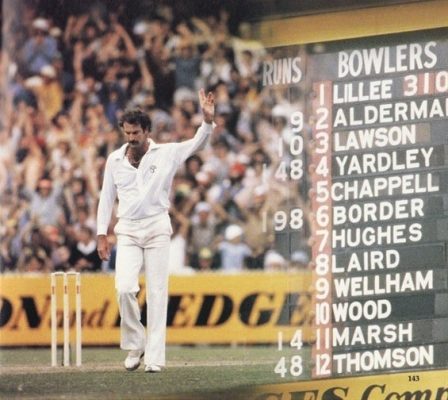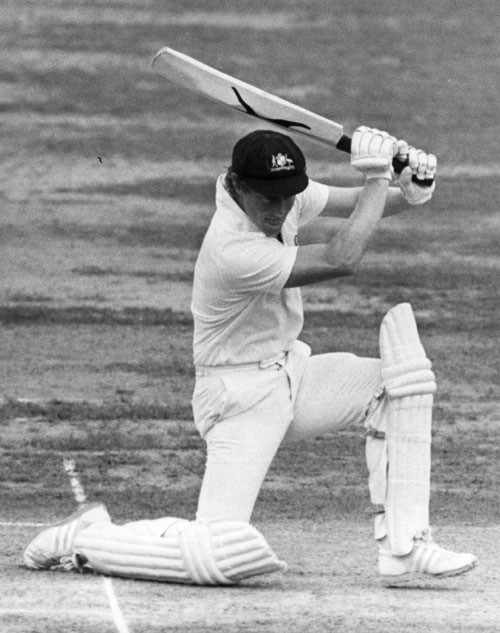In this week’s edition of In Search of West Indies Cricket, Roger Seymour begins to examine an oft overlooked aspect of the West Indies streak of not losing a Test series from the summer of 1980 to February 1995
Recently I was rummaging through my library when I stumbled across Edmar Mednis’ How to beat Bobby Fischer. Mednis’ classic book documents the 61 losses incurred by Bobby Fischer, one of the greatest chess players the world has ever seen, in the 576 games he played in tournaments and matches between 1958 and 1972.
Mednis was born in the Baltic state of Latvia and moved to the USA at the age of 13 with his parents. Educated as a chemical engineer, he worked as a stockbroker, but later became a professional chess player and author. He finished tied for third in the 1961-62 USA Chess Championship and in the 1962-63 Tournament, whilst playing with the black pieces, he achieved the enviable feat of being the first player to beat Fischer in the USA Championship tournament.

As I thumbed through the pages, glancing at the intricate analyses (my chess game at best can be described as below average) a question crossed my mind.
How many matches did the West Indies lose between the summer of 1980 and February 1995?
June 10 marked 38 years since the beginning of one of the most hallowed streaks in the history of test cricket. On that day in 1980, the West Indies beat England by two wickets in the First Test at Trent Bridge in Nottingham, a game they could quite easily have lost and thus began the magic carpet ride of a lifetime. As the weather played havoc with the other four Test matches, the 1-0 lead was good enough to win the series.
The West Indies remained unbeaten in their next 28 Test series, winning 20, including 7 in a row. They played 116 Test matches, won 59, drew 42 and lost only 15. The winning percentage was an incredible 50.86, while the losing percentage was just 12.93.
Fifteen losses: just one solitary loss per annum.
The streak came to an end with a 2-1 defeat at home to arch rivals Australia on May 2, 1995.
A Boxing Day century for the ages
While the rest of the world recovered from the celebrations of Christmas, Down Under, the Australians were getting ready for what had become a great tradition in the game, the Boxing Day Test match.
The first Test match to begin on Boxing Day was the Third Test of the 1974/75 Ashes series – a six-test affair – but there had been play on Boxing Day in three prior tests, in 1950, 1952 and 1968, the last versus the West Indies. The schedule was repeated the next year for the West Indies’ visit, and since 1980, it has become a permanent fixture on the Australian cricket calendar; the lone exception being an ODI against Sri Lanka in 1989.
The Melbourne Cricket Ground, the main venue for the 1956 Olympic Games and the 2006 Commonwealth Games, and the home of Victoria in the Sheffield Shield, has always been the venue. The ’G, as the residents refer to the heartbeat of their city, was established in 1853 and has a capacity of 100,024, making it the tenth largest sports stadium in the world.
First Test: Australia vs West Indies, Melbourne Cricket Ground, December
26-30, 1981
The first of three Tests of the1981/82 Australian tour began just ten days after Pakistan had inflicted an innings and 82-run defeat on the Australians, in the dead rubber match (Australia having won the first two tests) of their three match Test series, also at the ‘G.
The Australians made one change to their side, replacing Jeff Thomson with Geoff Lawson. The former and his new ball partner, Dennis Lillee went wicket-less as the Pakistanis amassed 500 for 8 declared. The pitch, which was two away from the one used for the Pakistan Test match, had been well watered, and was expected to provide help for the fast bowlers for the first two days.
Australian Captain Greg Chappell had been complaining bitterly to the Australian Cricket Board (ACB) for years about the unreliable pitches at the ‘G and had been calling on the ACB to have them re-laid. It was generally felt that winning the toss was going to be the crucial factor in the outcome of the Test.
Chappell won the toss, and surprisingly elected to bat, despite the ominous presence of the fast bowling quartet of Andy Roberts, Michael Holding, Colin Croft and Joel Garner in the West Indies line up.
In the fifth over of the match, Holding dismissed Bruce Laird and Chappell in consecutive balls, the latter for his fourth successive duck for Australia since the Pakistan Test. Soon after Australia were 8 for 3. Graeme Wood’s dismissal brought the Australian Vice-captain Kim Hughes to the crease.
Not long after, the Australians were reduced to 26 for 4, with all four dismissals being compliments of catches by wicketkeeper David Murray, three off Holding. The hosts were in dire straits in the opening hour of the series.
It was now up to Kim Hughes to lead the fight back, on a devil of a pitch, where the ball would keep low one delivery, and the next one, on virtually the same spot, was just as likely to fly over the batman’s head. Hughes hadn’t picked up a bat a week, family taking priority, as his father-in-law lay terminally ill in hospital.
Hughes decided to counterattack the fearsome quartet, playing shots all around the wicket, sparing no one. He pulled and drove fiercely. A savage square cut off for four off Holding took his score to 49, followed by an inside edge just over the stumps for another boundary to bring up his 50.
Wickets continue to tumble at the other end, as Hughes, adorned in an Aussie green helmet, sleeveless sweater and shirt sleeves rolled up to the elbows, battled the West Indians whilst shielding the tail enders. When the last man Terry Alderman joined his fellow Western Australian teammate, he advised Hughes that he was not planning to stick around too long and he should get on with it. Australia were 155 for 9, Hughes was on 71.
It was now or never for Hughes, who continued to challenge the West Indians. In one incredible moment he advanced down the wicket to the 6’8” Garner and smashed the ball through mid-wicket, giving the 12th man, Gus Logie the futile task of chasing it all the way to the boundary.
A savage square cut off Garner brought up an even 100 for Hughes, as a couple hundred exuberant fans stormed the field to congratulate their hero, while former hard-hitting Australian opening batsman (1966-74) turned commentator, Keith Stackpole raved to the television audience on the value of Hughes’ knock.
Alderman then nibbled one to Murray off Croft, having added 43 priceless runs with Hughes, as the Australian innings came to a close at 198. Hughes, appropriately undefeated on 100, with 11 fours, off 200 balls, in 262 minutes spread over three sessions, led the players off the field, as the plundered pace men duly acknowledged his masterpiece by leading the cheers, accompanied by a standing ovation from the 38,755 strong crowd.
The visitors were now faced with 35 minutes of batting. The appearance of Hughes on the field brought another rousing cheer from the crowd who were still revelling in the mastery of his innings. Now it was Lillee’s and Alderman’s turn with the new ball.

With the boisterous crowd chanting ‘Lillee! Lillee! Lillee!’ the Australian fast bowler steamed in with the last delivery of the day. Viv Richards aimed a cover drive at it and got an inside edge on to the stumps. West Indies: 10 for 4. The players scampered for the dressing rooms, as the ground erupted like never before.
Losing moment
“Games ebb and flow… especially in Test cricket where there are players who can suddenly take a match away from you in a couple of sessions…,” quoted from One-Man Committee by Ray Illlingworth and Jack Bannister.
In a low-scoring affair, such as this one, the match could easily have gone either way.
Roberts blamed the poor umpiring decisions for the West Indian defeat. He figured Border was caught at short leg in the second innings and went to make 60-odd, the difference in the match.
Umpiring decisions apart, Kim Hughes’ century was one for the ages. Former Australian Captain, now renowned commentator, Ian ‘Chappelli’ Chappell, no fan of Hughes (who suffered a lot at the hands of his team mates) rated it the “bravest innings I have ever seen played.” He noted that although Hughes batted at number five, he scored more than half his team’s runs, and was extremely daring in the circumstances – a pitch doing all kinds of things against one of the best ever pace attacks to step on a cricket field – despite being struck several times on the body.
Hughes’ innings swung the momentum the Australians’ way, as the West Indians suffered their first loss in 15 Test matches dating back to February 1980, the First Test versus New Zealand at Dunedin.
Milestones
There were other significant milestones in this Test match, any one of which under normal circumstances would have been well worth remembering the match for.
* At 2:55 pm on the second day of the match, Lillee had Larry Gomes caught by Chappell off an edge. It was his 310th Test wicket, making him the new world record holder. The former West Indian Test bowler, Lance Gibbs, the previous record holder, had been flown into Australia since the previous Test versus Pakistan by Kerry Packer’s Channel Nine television network, known to very few people, was then ushered onto the field to offer his congratulations to Dennis Lillee.
* Lillee achieved his best ever bowling figures in a Test innings with 7 for 83. He also equalled the record (held by S F Barnes and C V Grimmett) for the most 10-wicket hauls in a test match, as he completed the feat for the seventh time.
* Lillee finished 1981 with 85 wickets, to set a new record for the most wickets in a calendar year, surpassing Kapil Dev’s mark of 74 set in 1979.
* Holding’s match figures of 11 for 107, was a new record for West Indies versus Australia.
* David Murray’s 9 catches, achieved whilst playing with a broken finger, was at the time, second only to Englishman Bob Taylor’s 10 taken at Bombay during the 1979/80 Test series.
* The Melbourne Cricket Club announced during the match that it was going to relay the square over the next three seasons, commencing as soon as the season was over.
* It was the last Test match for the famous manual MCG scoreboard which had been

in service since 1907. The three-storey structure was taken down in January 1982, at the end of the season, and replaced in March 1982 with a state-of-the-art electronic Mitsubishi Diamond Vision video replay screen, only the fifth in the world at the time, at the cost of A$4 million. The classic scoreboard, which is operated by a nine-man crew, was transferred to the Manuka Oval, Canberra, where it is still in use.
* Greg Chappell, or ‘Chappello,’ as he was referred to, as the Australian cricket season progressed, would be accompanied off the field, three more times by the television cartoon character, Daddles the Duck, as he fell without scoring, in the fifth, sixth and seventh ODIs versus the West Indies in the Benson and Hedges World Series Cup, following the Test series, to Croft, Roberts and Garner, respectively, as all four West Indian pacers dismissed him for a duck on that tour.
* Jeff Dujon made his Test debut in this match, and at one stage looked like he was going to lead the West Indies to victory.
* There were no places in the side for either of the fast bowlers Malcolm Marshall or Sylvester Clarke, members of the tour party.






